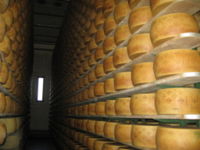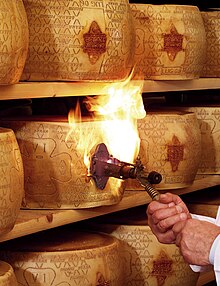Grana Padano: Difference between revisions
→Etymology: etymology is about the evolution of individual words. This is not an etymology |
→Production process: A effing photograph of the branding is in this article, you driveby tagging dillwad. |
||
| Line 57: | Line 57: | ||
==Production process== |
==Production process== |
||
Like Parmigiano Reggiano, Grana Padano is a semi-fat hard cheese which is cooked and ripened slowly for at least nine months. If it passes quality tests, it is fire-branded with the Grana Padano trademark. |
Like Parmigiano Reggiano, Grana Padano is a semi-fat hard cheese which is cooked and ripened slowly for at least nine months. If it passes quality tests, it is fire-branded with the Grana Padano trademark. The cows are milked twice a day, the milk is left to stand, and then partially skimmed.{{Citation needed|date=September 2015}} Milk produced in the evening is skimmed to remove the surface layer of cream and mixed with fresh milk produced in the morning. The partly skimmed milk is transferred into copper kettles and coagulated; the resulting curd is cut to produce granules with the size of rice grains, which gives the cheese its characteristic texture, and then warmed to {{convert|53|-|56|C|F}}. It is produced year-round and the quality can vary seasonally as well as by year. Though similar to [[Parmigiano-Reggiano#Other cheeses sold as Parmesan|Parmigiano Reggiano cheese]], the younger Grana Padano cheeses are less crumbly, milder and less complex in flavor than their better known, longer-aged relative.<ref name="cheesecom"/> |
||
On an annual basis, the Grana Padano consortium exports [[Euro|€]] 750 million ([[Pounds sterling|£]]570 million) of their product.<ref name="Vogt"/> |
On an annual basis, the Grana Padano consortium exports [[Euro|€]] 750 million ([[Pounds sterling|£]]570 million) of their product.<ref name="Vogt"/> |
||
Revision as of 18:57, 7 January 2018
This article has multiple issues. Please help improve it or discuss these issues on the talk page. (Learn how and when to remove these messages)
|
| Grana Padano | |
|---|---|
 | |
| Country of origin | Italy |
| Region, town | Emilia-Romagna: province of Piacenza Lombardy: Trentino: Veneto: In addition to these main centres |
| Source of milk | Cows |
| Pasteurised | No |
| Texture | Hard |
| Aging time | 8–20 months |
| Certification | Italy: DOC 1955 EU: PDO 1996 |
Grana Padano (Italian pronunciation: [ˈɡraːna paˈdaːno]) is a hard, slow-ripened, semi-fat cheese from Italy, comparable to Parmigiano Reggiano (commonly known as parmesan cheese). Grana Padano has had protected designation of origin status since 1996.[1] It is made from milk produced in the Po River valley.[2]
Origin of the name
The name comes from the Italian word grana, a reference to the characteristically grainy texture, and the demonym padano, referring to (cheese from) the Po Valley area of northern Italy.
History
Grana Padano is one of the world's first hard cheeses, created nearly 900 years ago by the Cistercian monks of Chiaravalle Abbey, founded in 1135 near Milan[1] By the year 1477, it was regarded as one of the most famous cheeses of Italy.[according to whom?] It can last a long time without spoiling, sometimes aging up to two years. It is made in a similar way to the Parmigiano Reggiano of Emilia-Romagna but over a much wider area and with different regulations and controls.[1]
Production process
Like Parmigiano Reggiano, Grana Padano is a semi-fat hard cheese which is cooked and ripened slowly for at least nine months. If it passes quality tests, it is fire-branded with the Grana Padano trademark. The cows are milked twice a day, the milk is left to stand, and then partially skimmed.[citation needed] Milk produced in the evening is skimmed to remove the surface layer of cream and mixed with fresh milk produced in the morning. The partly skimmed milk is transferred into copper kettles and coagulated; the resulting curd is cut to produce granules with the size of rice grains, which gives the cheese its characteristic texture, and then warmed to 53–56 °C (127–133 °F). It is produced year-round and the quality can vary seasonally as well as by year. Though similar to Parmigiano Reggiano cheese, the younger Grana Padano cheeses are less crumbly, milder and less complex in flavor than their better known, longer-aged relative.[1]
On an annual basis, the Grana Padano consortium exports € 750 million (£570 million) of their product.[3]
Specifications
A wheel of Grana Padano is cylindrical, with slightly convex or almost straight sides and flat faces. It measures 35 to 45 cm (14 to 18 in) in diameter, and 15 to 18 cm (5.9 to 7.1 in) in height. It weighs 24 to 40 kg (53 to 88 lbs) per wheel. The rind, which is thin, is pale yellow.[1]
Grana Padano is sold in three different ripening stages:[4]
- "Grana Padano" (9 to 16 months): texture still creamy, only slightly grainy
- "Grana Padano oltre 16 mesi" (over 16 months): crumblier texture, more pronounced taste
- "Grana Padano Riserva" (over 20 months): grainy, crumbly and full flavoured

Grana padano cheese typically contains cheese crystals, semi-solid to gritty crystalline spots that at least partially consist of the amino acid tyrosine.
Controversy
In May, 2016, the Grana Padano consortium filed a legal action against the producers of the U.S. television soap opera series The Bold and the Beautiful for a scene wherein it was claimed the product was disparaged.[3]
See also
References
- ^ a b c d e "Grana Padano - Cheese.com". www.cheese.com. Retrieved 29 May 2016.
- ^ "Know your Italian cheeses: Grana Padano vs. Parmigiana-Reggiano". New York Daily News. September 11, 2008. Retrieved September 10, 2016.
- ^ a b Vogt, Andrea (24 May 2016). "Italian Grana Padano producers sue US soap opera over scene inferring it's a poor man's Parmesan". Daily Telegraph. Bologna. Retrieved 10 September 2016.}
- ^ Gillingham, Sara Kate (October 8, 2008). "A Primer on Grana Padano". Retrieved September 10, 2016.
